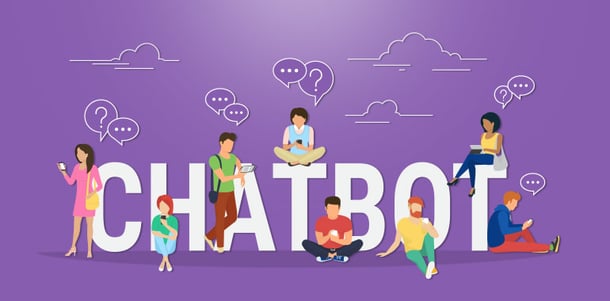Enterprise chatbots are revolutionizing businesses worldwide by transforming the way businesses communicate with customers in resolving their issues. Specifically, in the age of experience-as-an-economy, AI-powered chatbots with the ability to offer personalized interaction experiences, are offering innovative solutions to influence customer experience and build a valuable brand reputation. For this reason, Markets and Markets research reveals "the global Chatbot market size is predicted to grow from $2.9 billion in 2020 to $10.5 billion by 2026." This trend clearly shows the rising demand for chatbots. Here we discuss the top reasons why chatbots are needed for your business to transform customer service.
Ways Chatbots Improve Customer Service Efficiency and Experience
1. Reduce Resolution Time and Cost
Customers get annoyed while waiting in the Interactive Voice Response (IVR) queue for customer service agents to attend to their issues. The time to connect with a customer service agent increases with an increase in the number of requests. Recruiting human agents to solve issues is costly and isn’t a feasible solution.
Over two thirds (68%) of business respondents agree that their agents struggle with the volume of customer requests”.
A single customer service chatbot can be available 24x7 and costs less than around-the-clock staff. Chatbots reduce work pressure and remove redundant work of customer service reps and provide better assistance with quick response times. A single chatbot can immediately respond to any number of customers at any given point and eliminate the need to depend on customer support staff for general queries. Chatbots can offer self-assistance solutions to customers, which saves customers time.
2. Report and Track Issues Intelligently
Oftentimes, customers don't know which stage their issue is in and how much longer it will take to resolve. Even if businesses provide a customer service portal to report issues, customers need to go through a catalogue of menus to report issues appropriately. Even to track the issue, they have to login into the portal which is confusing and time-consuming. With chatbots, customers don't have to worry about the category or routing process, instead, chatbots take care of the entire process and provide real-time updates.
Chatbots engage with customers and report, track, and resolve their issues. To track issue status, chatbots send push notifications to customers if any change in issue status is observed. Chatbots automate routine customer communication processes and provide information based on general queries. This enables customer service agents to spend time on more crucial issues that require human attention.
3. Make Customer Service Processes Effortless
Some customer issues may require human agents to connect across different departments to answer a customer's question. Legacy CSM systems are not integrated with other enterprise systems thereby obstructing information flow across departments. The manual process increases the complexity of the customer service workflows, affecting the agent's productivity and time to resolve the issue.
Deploying an AI-powered chatbot that is integrated with enterprise systems and CSM is a great solution. The customer service reps just ask the chatbot for the desired information and the chatbot immediately retrieves the information with complete analysis and possible solutions for the customer. A chatbot can retrieve the appropriate knowledge base article from a database and suggest solutions. This way chatbot improves CSM workflow efficiency.
Chatbots help companies save up to 30% of their customer support costs by speeding up response times, freeing up agents for more challenging work, and answering up to 80% of routine questions.” - IBM
4. Evaluate CSM Efficiency and Drive Business Decisions
As AI chatbots are integrated within enterprise systems, they can study customer interactions and CSM workflow data. The chatbots integrate all the data sources to ensure data agility and receptiveness. CSM platforms integrated with AI chatbots result in improved service delivery efficiency, minimized operational costs, traceability, and enhanced data accessibility.
Driven by AI competencies, chatbots create data analytics about customer service delivery patterns and efficiencies. The analytics accelerates business decisions and restructures CSM operations to serve customers better.
5. Communicate Where Customers Are - Messaging Platform Integration
A little more than half of the world's population are social media users. On average, people spend close to two and a half hours on social platforms each day. According to Statista, in 2021, WhatsApp has two billion users, Facebook Messenger has 1.3 million users and WeChat has 1.2 million users. These stats clearly show that most users are communicating through social and messaging platforms. Businesses cant use just one communication channel, instead they should communicate with customers on the apps they are comfortable with. So, integrating enterprise customer service chatbot systems with social and messaging platforms is a must.
Integrating a chatbot application to messaging and social media apps will broaden a business' service capabilities and also provides an opportunity to promote its services. This works well for B2C businesses. For example, e-commerce sites, restaurants, and hotels can integrate a chatbot within their Facebook Page, company website, CSM portal and mobile app. This expands marketplace reach and creates better customer engagement.

6. Continuous Service Delivery
With businesses operating in different time zones, it is impractical for customer service agents to address customer issues 24/7. Moreover, recruiting customer service reps to manage frequent calls 24/7 isn’t easy. In the meantime, availability of service or delay in issue resolution can affect customer satisfaction and retention.
Chatbots can help the CSM team automate the most repetitive tasks (FAQs, self-service) and offer 24/7 help to customers located in any location. In case of complexity, the chatbot can forward the request to a human agent to handle the issue. This way, chatbots serve customers 24/7, thereby improving customer engagement and satisfaction.
7. Analyse Customer Trends
Customer service chatbot applications are exceptionally useful in recording and learning from conversations. Natural Language Processing and Understanding (NLP/NLU) capabilities study the entire communication log and provide insights into customer behavior. This information helps determine requirements and identify opportunities for improvement. Using push notifications, chatbots can notify or remind users proactively about service upgrades and fixes.
On the other side, these communication logs can also be used to assist the sales process. A customer persona is crucial to the sales process. Salespeople can retrieve the customer’s company info and track respective social profiles to plot a customer persona.
8. Enhance Customer Experience
AI-powered chatbots with cognitive learning capabilities analyze customer interactions and behaviour. Developers can use this information to create a behavioural map and offer personalized conversational experiences. The Natural Language Processing capabilities enable chatbots to understand customer needs and use exceptional dialogue management to emotionally relate with users in a more human approach.
















